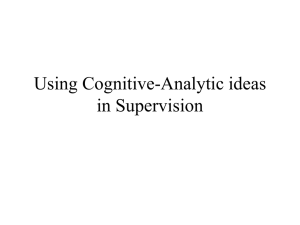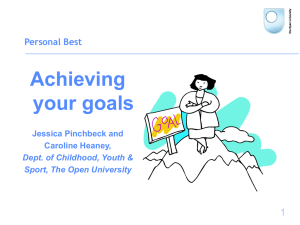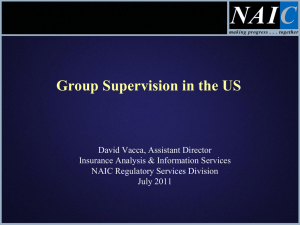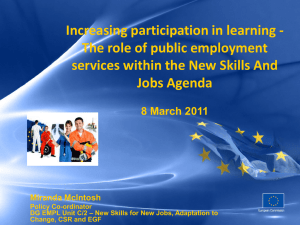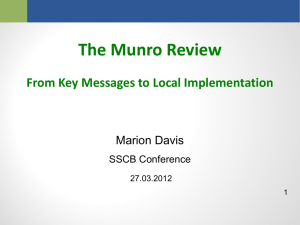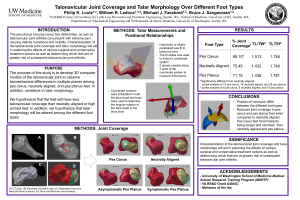the paper in full - Centre for Social Work Practice
advertisement
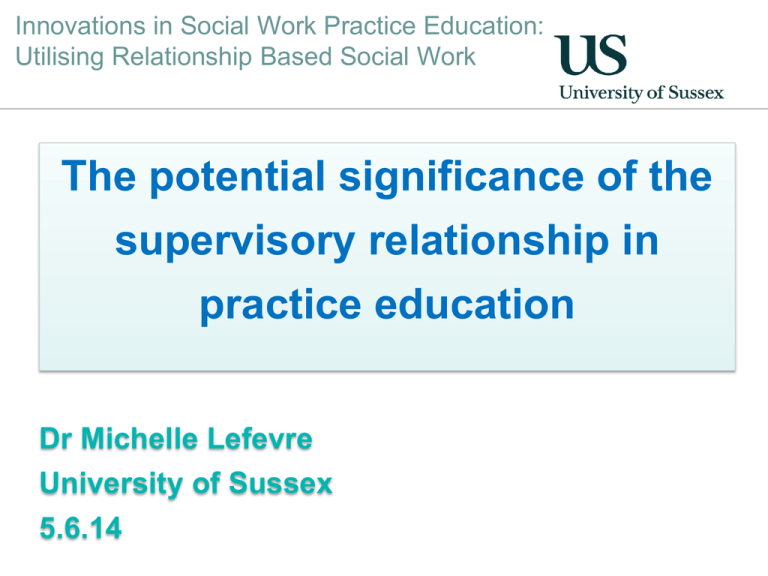
Innovations in Social Work Practice Education: Utilising Relationship Based Social Work The potential significance of the supervisory relationship in practice education Dr Michelle Lefevre University of Sussex 5.6.14 The focus of this presentation • What the supervisory relationship is nested within • Why the relationship might matter • What can go well/go wrong • What Practice Educators need to be attuned to • How PEs might support themselves/be better supported by their agencies 2 Complex networks of supervisory relationships (1) PE/WBS Student Tutor/University 3 • Potential for splitting/ projection • Fantasies/ prejudices • Phantasies • Transference, countertransference Complex networks of supervisory relationships (2) • Power, status and influence • Whose voice counts? • Valuing and respect • Fears or trust • Alignments • Cracks 4 Tutor PE WBS Student Complex networks of supervisory relationships (3) What is enacted between the supervisor/student is influenced/reflected by others around them Peers (Mattinson, 1975). Where are the family/individuals positioned and how are they understood/helped within the supervisory relationship? (systemic) 5 Team Uni Supervisor Student Nests: containment or impingement? National policy & practice context University Agency PE/WBS Student Service user 6 So, what is the importance of the supervisory relationship in these networks? • Technical considerations are important • But good PE also associated with emotional and processoriented factors (Doel et al, 2004) • PE can be the reflective container for students’ responses to: - complex, challenging, distressing client situations (Ferguson, 2011; Munro, 2011) - anxiety and drop in confidence from being a learner and being assessed (Salzberger-Wittenberg et al., 1983) 7 Earlier models of supervision in PE • Early quasi-therapeutic models focused on internal world (e.g. Taft, 1950; Hamilton, 1954). • Students concerned about boundaries and intrusion (Kadushin, 1974) • Role systems (Wijnberg & Schwarz,1977) more egalitarian and collaborative; Growth in understandings of power and antioppressive practice • Downside: PEs wary of considering the more affective, processoriented and interpersonal components of their interaction with students and of students with service users (Bogo, 1993) 8 What have students said about the importance of the relationship? (Lefevre, 2004) • 2004 written survey, qualitative & quantitative data • Sample: 72 students who were undertaking a qualification programme in social work, either MSW or DipSW level, England. • Undertaken 2 weeks after they had received their final report from the practice teacher • 44 completed the survey (61% of sample frame) • 17 were in first placement, 27 final placement (reviewed both placement experiences) • No demographic data • Limitations: influence of feelings about recent PE assessment 9 Positive words and phrases used by students to describe rel with PE (1) • 78 words reflected positive aspects of the relationship. - ‘supportive’ appeared 34 times, used by 48% - ‘friendly’ (13 times); ‘helpful’ and ‘good’ (11); ‘positive’ (7); encouraging’, ‘relaxed’ and ‘understanding’ (6); ‘informative’, ‘respect(ful)’, ‘warm’ and ‘open’ (5). • 26 of these denoted a supportive relationship: - ‘kind’, ‘nurturing’, ‘caring’, ‘warm’, ‘rewarding’, ‘friendly’, ‘considerate’, ‘fun’, ‘sensitive’, ‘encouraging’, ‘approachable’, ‘understanding’, ‘accommodating’, ‘trusting’, ‘confidence-giving’. • Some reflected a person-centred approach by PE: - ‘empathic’, ‘congruent’, ‘valued’. 10 Positive words and phrases used by students to describe rel with PE (2) • 16 suggested a relaxed learning environment: - ‘comfortable’, ‘informal’, ‘flexible’, ‘easy-going’ or ‘laid-back’ • 28 indicated a relationship with an anti-oppressive and collaborative approach with dynamics of empowerment, respect, mutuality, fairness and transparency: - ‘good communication’, ‘a sharing of ideas’, ‘an equal relationship where anything could be discussed’ and a sense that they were ‘learning together’. - This resulted in students feeling ‘listened-to’ and ‘included’ and that they were part of a team. 11 More negative words and phrases (1) • 47 words indicated negative dynamics in the relationship: - ‘strained’ (3); ‘demanding’, ‘distant’, ‘stressful’, ‘unhelpful’ (2). • 16 signified a lack of support, warmth and friendliness: - ‘unapproachable’,‘unvalued’, ‘uncomfortable’, ‘distant’ ‘impersonal’. • 2 students felt negative because the practice teacher was overfriendly and supportive • Some indicated tension in the relationship: - ‘strained’,‘inflexible’, ‘wary’, ‘prickly’, ‘awkward’, ‘stressful’, ‘unpredictable’, ‘tempestuous’; ‘worrying’ about the practice teacher’s mood; ‘on a rollercoaster ride’. 12 More negative words and phrases (2) • 12 related to the practice teacher’s availability, such as • ‘always busy’, ‘rushed’, ‘stretched’, ‘basic’, ‘bare minimum’; low priority, a burden or nuisance. • For 13 the relationship was oppressive - an ‘unconstructive’, ‘confrontational’ even ‘degrading’ relationship in which they felt ‘domineered’, ‘bullied’ and ‘controlled’. - their ‘self-confidence and self-esteem plummeted’; they ‘never knew whether [they were] right or wrong’; ‘not listened to’; left to ‘get on with it’. - Stereotyping: ‘Presumptions were made but questions never asked’. - One described the practice teacher as ‘Very racist’. • 1/3 indicated transference and counter-transference 13 - ‘Mother and son (I was the son)’. Students’ perceptions of whether and how the relationship had an impact on their learning and development • 90% believed that the relationship with their practice teacher had had either ‘a lot’ or ‘a bit’ of an impact on their learning and development • When asked ‘how’, the theme of supportiveness dominated (31 statements) • A lack of support experienced in the relationship negatively affected respondents’ development • Worries that over-supportiveness was also unhelpful • Where PEs lacked competence, this caused the student to feel negatively about the relationship 14 Whether and how the relationship affected the effectiveness and accuracy of the assessment (1) • 77.5% rated the relationship as having impacted the effectiveness and accuracy of the assessment • A collaborative and trusting relationship enabled a fuller picture of their competence to emerge, resulting in a fairer, more accurate and more transparent assessment process. • 4 believed that the way power had been mishandled in the relationship had adversely affected their assessment 15 Whether and how the relationship affected the effectiveness and accuracy of the assessment (2) • 4/5 suggested correspondence between feeling positive about the relationship and believing the assessment to be effective and accurate • 6 questioned whether their positive relationship with PE made it less fair because of bias or reluctance to challenge • Half of the 9 who had a negative relationship felt it had an impact on the effectiveness and accuracy of the PE assessment • But 3 others still felt they received a fair assessment 16 What influenced the development of the student’s relationship with their PE 17 • How much student felt listened to/heard by the practice teacher 83.1% • How much student felt respected and valued by the practice teacher 80.3% • Trust/safety (or lack of) 74.6% • The way in which critical feedback was given 66.2% • The practice teacher’s capacity to provide emotional support 66.2% • How much student felt the practice teacher showed them warmth 63.4% • Issues in the power relationship 50.7% • The practice teacher’s availability due to agency pressures 43.7% • Personal stress on the part of the practice teacher 38% • Personal stress on the part of the student 36.6% • Transference/counter-transference 31% • Issues of race/gender/age/class/disability/sexuality 23.9% So what can we take from this? • Powerful feelings are generated in practice learning, e.g. anxiety, vulnerability, under-confidence, powerlessness, hope, dependence • These have a foundation in the relationship between the student and the practice teacher. - Relating to the roles they inhabit - Each others’ expectations of these roles - And how they each embody these roles 18 Unhelpful if processes go all one way STUDENT PRACTICE EDUCATOR • Learner • Teacher • Recipient of • Cared for • Child 19 One way assessment • Assessor • Carer • Parent This model implies a striving for reciprocity STUDENT Learner Assessee Cared for Child 20 MUTUAL PRACTICE EDUCATOR Both learning Self & other evaluation Mutual caring & recognition of other Adult Teacher Assessor Carer Parent This improves both learning and assessment • Supportive experiences are also significant to perceptions of the accuracy and fairness of the PE assessment • More trust meant they were more willing to expose fallibility and be open to critical feedback • So assessment based on the fullest of information • An ongoing constructive looping process between formative and summative assessment, maximizing learning opportunities. • The reverse was caused by ‘expectations clash’, uncollaborative, non-transparent approach to assessment 21 Crucial to consider developmental stages and needs of each Student • Some vulnerable/anxious and more dependent at the beginning • Psychodynamic model allows for stage of nurturing (horticultural) • So student has time to ‘grow up’ • But not to ‘full independence’ but aiming for Fairbairn’s ‘mutual dependence’ & resilience (ongoing needs for learning & support) 22 Practice educator • What stage is PE at in supervisory career? • What might stop them supporting? • What is the nature of their own practice context? • How much learning/ nurturing are they receiving? • How resilient? So what are the implications for Practice Educators? Agency PE/WBS • The need for the agency to contain the PE, who contains the student, who contains the service user Student Service user • The student learns how to do this experientially for their own practice But PEs need workplace environment that supports them • PE can’t be supportive in an unsupportive environment - ‘Emotional responsiveness and capacity are not merely a product of individuals, but are powerfully influenced by collective and contextual processes, including workplace, professional and socio-cultural factors’ (Morrison, 2007, p. 253). • Enhanced self-awareness, rigorous self-reflection and a context for practice which facilitates this are required: - To be able to practise well, social workers have to be employed in an organisation that supports them and their professional development (Munro, 2011, p. 105) 24 The role of the organisation and PE • If workers don’t feel safe, they won’t separate from the office or car (Ferguson, 2011) • Workers need a ‘container’ (the organisation) to hold/make bearable these overwhelming feelings and create a safe reflective space – PE does for student (Bion, 1962) • Supervisor aims to understand and name students’ feelings and needs by receiving them herself – counter-transference? What the student can then experience • Repeated experience of an attuned response in supervision leads students to feel what is happening to them is understandable • It makes their experience bearable and nameable • So uncertainty and anxiety become more manageable • This generates higher level emotional and cognitive development in the student and an ability to ‘hold’ the client • Although containment originally comes through the relationship, this process is internalised and the student learns to do it for him/herself: → reflective practice Practitioners who were more able to reflect are more: • Committed to conceptualising and developing their practice • Able to explore alternative perspectives • Able to embrace and engage with uncertainty, complexity and risk • ‘Mindful’ and ‘whole-hearted’ when engaging with practice • Responsive, responsible, relational and empowering regarding partnership with service users • Able to critically scrutinise their affective responses to encounters so that they become another source of knowledge (Ruch, 2011) What happens when the supervisor does not act as a container • The emotions don’t go away; instead: - This developmental construction process is impaired - Thoughts and feelings remain unprocessed and fragmented • Not only is the student left with unbearable anxiety in the moment but she does not learn how to reflect effectively on or in action (Schon, 1983). • Supervision in PE does not become either a support or a transformatory experience • Unhelpful defence mechanisms develop, - e.g. Menzies-Lyth (1998): ‘the liver in bed nine’ - detachment - Engaging more in routine and procedural tasks - Burn-out, illness Process reflection (1) • Psychodynamic theories - Defences against unbearable anxiety - Splitting/ project - Transference/counter-transference - What is happening between us in the here and now? - How might this reflect what is happening with the service user? - How might it relate to students/PEs’ usual patterns? 29 Process reflection (2) Transactional analysis Games People Play (Berne, 1964) - ego states 30 - Parent critical/nurturing - Parent critical/nurturing - Adult - Adult - Child free/rebellious/ adaptive - Child free/rebellious/ adaptive Process reflection (3) Drama Triangle (Karpman): Victim Rescuer 31 Persecutor Self-awareness • Professionals are every bit as capable of repression, splitting, projection and transference as service users. • PEs are every bit as capable of repression, splitting, projection and transference as students….. • What patterns have you noticed? • What feeling states/processes are you most likely to accuse others of? They may be yours….. 32 Developing resilience in SW students (drawing on Beddoe et al, 2011; Grant & Kinman, 2011) • Decline in well-being in NQSWs; retention is decreasing • Students will need skills to enable them to ‘thrive and survive’ in practice careers - both personal qualities and readiness to manage self and emotions in the turbulent workplace • How may PE support students’ personal dispositions so that hopefulness, altruism, empathy, optimism, coping and personal robustness may be nurtured? • It is a multi-systemic process. Students have a personal responsibility for their own self-development but the organisation/PE has to be safe and containing to promote this How the organisation and supervision may help (2) • Promote development of students’ clear professional identity with an understanding of what this role realistically will involve • ‘Identity building’ work, to explore and articulate : - Who am I with this new professional identity? - What do I believe in? - What are my aspirations? - What will I stand up for?’ • Demonstrate professional ethics and qualities - You demonstrating nurturing, compassion, authority, respect, self-awareness and strong boundaries How the organisation and supervision may help (3) • Supporting students developing coping strategies and maintaining appropriate work–life balance • Recognising personal journeys and motivations and the need to process these (e.g. ‘rescuer’, need to be liked). • The importance of clear personal and professional boundaries • Mindfulness and other awareness enhancing techniques (e.g. yoga): - Can help students manage stress & cope more effectively with their own emotional states and highly charged emotional states of others - Can help facilitate students’ active listening, promote self-awareness and enhance critical reflection - Can support students to develop their capacity for deep reflection and enhance their emotional intelligence How the organisation and supervision may help (4) • Using CBT techniques to help students manage guilt, worry, blame (Grant & Kinman, 2011) - Identify how thinking errors and negative automatic thoughts may prevent students from thinking constructively and non-blamingly about work situations • Action planning • Primary appraisal: the student makes a conscious evaluation of an event such as a harm or a loss, a threat, or a challenge. • Secondary appraisal takes place when the student asks himself or herself, ‘What can I do about it?’ - evaluating the internal and external resources available to them that have the potential to buffer stress reactions (Bakker et al., 2004). • Develop realistic goals that are not too easy or too difficult to achieve. Peer Coaching among PEs to develop their own reflective practice • Peer coaching draws on Grant & Kinman’s (2011) work on resilience • A collaborative relationship to facilitate development of skills through feedback, reflection and self-directed learning in a safe dyadic space • Helps PEs identify personal strengths as well as perceived weaknesses, so promotes self-awareness and facilitates reflection on their practice of PE • Benefits social-emotional development and improved interpersonal skills such as active listening, questioning and probing, for each PE. • Exercise A: Coach helps coachee to adopt a solution-focused, rather than problem-focused, approach to difficulties they may encounter in PE • Exercise B: Coach asks coachee to identify ‘Sparkling Moments’ - times in their work when they felt particularly successful and satisfied. Explore what made this situation satisfying, and consider how to maximise such opportunities in future. Some questions to ponder • How well do you feel you are able to offer this kind of containment and promotion of reflective, resilient practice through your supervisory style? (appraise current capabilities) • What might get in the way of you doing this better? (looking for blocks or skill gaps) • What strategies could you develop to improve your own practice (and that of your organisation, too, if possible)? References • Beddoe, L., Davys, A. & Adamson, C. (2011): Educating Resilient Practitioners, Social Work Education: The International Journal, Advance Access DOI:10.1080/02615479.2011.644532 • Bion, W. (1962) Learning from Experience. London: Heinemann. • Bogo, M. (1993) ‘The student/field instructor relationship: the critical factor in field education’, The Clinical Supervisor, vol. 11, no. 2, pp. 23– 36. • Doel, M., Deacon, L. & Sawdon, C. (2004) An Audit of Models of Practice Learning in the New Social Work Award, http://www.practicelearning.org.uk/ • Ferguson, H. (2011) Child Protection Practice. Palgrave Macmillan 39 References • Grant, L. & Kinman, G. (2011): Enhancing Wellbeing in Social Work Students: Building Resilience in the Next Generation, Social Work Education: The International Journal, Advance Access: DOI:10.1080/02615479.2011.590931 • Hamilton, G. (1954) ‘Self-awareness in professional education’, Social Casework, vol. 35,pp. 374–377. • Lefevre, M. (2005) 'Facilitating Practice Learning and Assessment: The Influence of Relationship', Social Work Education, 24:5,565 — 583 • Mattinson, J. (1975) The Reflection Process in Casework Supervision. London: Tavistock Institute. • Menzies-Lyth, I. (1988) Containing Anxiety in Institutions: Selected Essays, Volume 1. London: Free Association Books. 40 • Morrison, T. (2007) Emotional Intelligence, Emotion and Social Work: Context, Characteristics, Complications and Contribution, British Journal of Social Work ,37, 245–263 • Munro, E. (2011) The Munro Review of Child Protection:Final Report. http://www.education.gov.uk/childrenandyoungpeople/safeguardingchild ren/protection/b00219296/munro • Ruch, G. (2007) Reflective Practice in Contemporary Child-care Social Work: The Role of Containment, British Journal of Social Work (2007) 37, 659–680 • Ruch, G.(2011) Where have all the feelings gone? developing reflective and relationship-based management in child-care social work, British Journal of Social Work,Advance Access doi:10.1093/bjsw/bcr134. 41 • Salzberger-Wittenberg, I., Henry, G. & Osborne, E. (1983) The Emotional Experience of Learning and Teaching, Routledge and Kegan Paul, London. • Taft, J. (1950) ‘A conception of the growth process underlying social casework practice’, Social Casework, vol. 31, pp. 311–318. • Wijnberg, M. H. & Schwartz, M. C. (1977) ‘Models of student supervision: the apprentice, growth and role systems models’, Journal of Education for Social Work, vol. 13, no. 3, pp. 107–113 42

